Radio’s main ingredients are music, sounds and voices. How should we use them to create effective imaging, branding and promotion through audiovisual productions?
Julian Treasure of The Sound Agency spoke passionately about sound, listening and the future of radio at the Lokalrundfunktage 2012. On the radio, we have to communicate effectively in sound. Therefore, I’ve collected takeaways on how sound can trick senses, change perceptions and determine behavior through the power of recognition and association.
“Sound goes very deep, very fast”
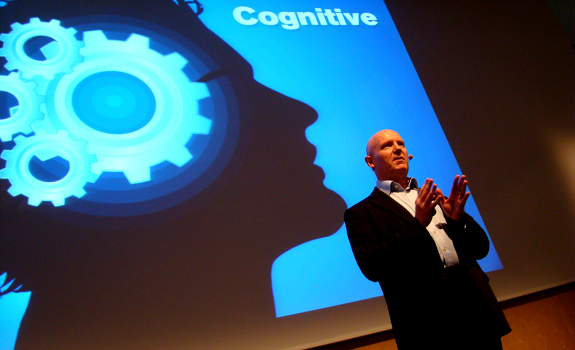
Radio’s direct link to human emotions makes it a powerful medium, says brand consultant Julian Treasure of The Sound Agency during his speech at Lokalrundfunktage 2012 in Nürnberg, Germany (photo: Thomas Giger)
Leverage power of sound
“Sound affects all of us”, says Julian Treasure. He mentions 4 ways how audio is influencing people:
1. Sound influences us physiologically
Audio affects our body. Hard, loud, sharp, high-frequent noises (like a disturbing door bell) release the stress hormone cortisol, which gives us a fight or flight signal. Apart from hormonal changes, sound affects other physical aspects, like our breathing, heart rate, and brain waves. Soft, gentle, warm, low-frequent sounds (like waves on the beach) cause our body to relax.
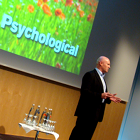 2. Sound affects us psychologically
2. Sound affects us psychologically
Audio influences our mind. The sound of singing birds in a rain forest is something that many people find deeply reassuring. It makes people mentally alert at the same time, as we all have learned that when the birds are singing, it’s time to be awake. Sounds like these create a relaxed state of mind and work very well in crowded places like airports or shopping malls.
3. Sound diffuses us cognitively
Audio distracts our understanding. Following 2 conversations simultaneously is already tough, but open plan offices are devastating for knowledge workers. Their productivity can drop as much as 66% due to a decreased cognition. When other people talk while you think, it interrupts your internal voice and you can’t focus. Music (especially with vocals) distracts, too – repetitive (ambient or trance) music works best.
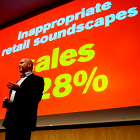 4. Sound changes us behaviorally
4. Sound changes us behaviorally
Audio alters our behavior. We consciously decide to move away from unpleasant sounds, but often it happens on a subconscious level. People turn around on the doorstep or don’t go near a shop at all when it has inappropriate music or terrible acoustics, and they usually don’t think about it. Research has proved that bad soundscapes can cause retail sales to drop as much as 28%.
Avoid causing crossmodal effects
Radio imaging and station sound producers will sometimes also produce sound for TV commercials, so the following is relevant for radio. Recent cognitive psychology research, led by professor Charles Spence of the University of Oxford, gives us some interesting insights in how listeners consume content. When a message reaches our senses (we can see, hear, feel, smell and taste), crossmodal effects can appear. Our senses cannot be taken separately; they influence each other. Here’s a fun experiment:
- Click below and watch the following movie. What do you hear?
- Play it again, but this time close your eyes and just listen. What do you notice?
Influence perception through sound
Indeed, you probably first ‘heard’ ga-ga, or maybe da-da. It’s something that your mind makes up, based on what you see. When you remove the visual distraction by closing your eyes, you might have been surprised that he actually says ba-ba. This is known as the McGurk effect. That what we hear, is not necessarily real… The fact that sound can change people’s perception is shown by this crisp experiment. Some product packages are specifically designed to produce a sound that enhances customer satisfaction, which increases product sales. Listen to this case study:
[audio:http://www.radioiloveit.com/wp-content/uploads/Julian-Treasure-Lokalrundfunktage-2012-1.mp3|titles=Julian Treasure Lokalrundfunktage 2012]
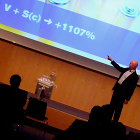 Increase additivity through congruence
Increase additivity through congruence
Julian Treasure advises to communicate in a way that aligns all senses, by which you create so-called super additivity. Neuroscientists have found that when you add a congruent sound to a visual message, it becomes 12 times as effective (an increase of 1107%). This shows, for example, that music in TV commercials should always (literally) fit into the picture!
Avoid loss from non-congruence
When not all senses get the same impression, it can destroy a lot. The same brain research shows that when you add a non-congruent sound to a visual message, it becomes 7 times less effective (a decrease of 86%, which means that just 14% of the original message remains). BRAND sense calculated that Fortune 500 companies spend 83% of their marketing budget on visual communication. When you ask people which senses are most important for them, sight comes first – but soon followed by smell and sound.
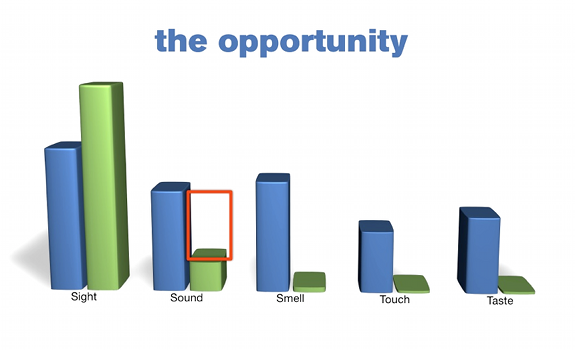
The importance of sight, sound, smell, touch and taste according to consumers (blue), versus the corresponding ad spend by Fortune 500 companies (green) – suggesting that big companies could easily invest their overspending in terms of visual advertising on audio commercials, and trigger both senses more equally (data: BRAND sense)
Unleash radio’s emotional strength
Fortune 500 companies could easily use their over-spending on sight to fill the gap at sound. In this regard, Julian Treasure speaks of an “exiting and huge” opportunity for radio. It turns out that we see things very consciously, but we hear things mainly unconsciously. Visuals go into the cortex and are then being interpreted by the brain, whereas sounds go straight into the limbic system. “Sound goes very deep, very fast, which is one of the reasons why radio is such a powerful medium.” This implies that smart produced radio commercials can achieve a lot of effect.
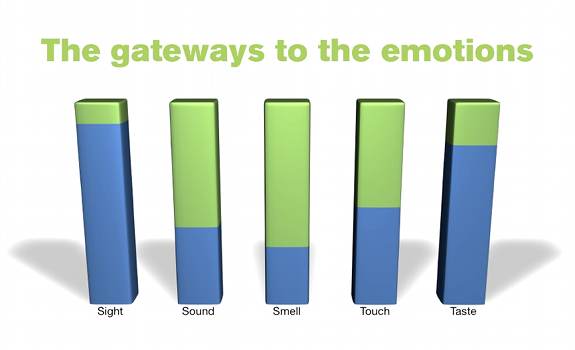
Conscious (blue) and unconscious (green) components of 5 senses – illustrating that visuals trigger predominantely (conscious) thoughts, while sounds trigger much more (subconscious) emotions (data: BRAND sense)
Choose background music strategically
Radio can learn from supermarkets. They use music to keep us shopping longer, but it can even influence our choice of products. In one case, researchers visually displayed French and German wines exactly the same, but they altered the background music day by day. On days that they played French music, 5 French wines were sold for every German one – but on German music days, 2 German wines were sold for every French one! The theory that background music is influencing people unconsciously was proven once again when the customers were being asked if they’ve bought the German wine because the store played music in that language. Most people replied by asking: “What music?”.
 Keep associative brand sound
Keep associative brand sound
However, when music is closely associated with your brand, always think twice before changing it. For many years, British Airways used a classical piece as their musical identity. Then they switched to another ad agency and introduced a cover of Leaving on a jet plane as new theme. Julian Treasure jokes that the second line of that song is Don’t know when I’ll be back again. “It’s written by John Denver, who died in a plane crash…”
Use ‘recognition + association = power’
Thousands of customers complained about Leaving on a jet plane and wanted ‘their’ classical music back. “British Airways had a really big sonic asset in the relationship with that piece of music”, says Treasure. He notes that people recognize music very fast and associate with it very quickly, which are the reasons why “music is very powerful. Unfortunately it’s used irresponsibly in many cases; as a background sound. The intention of music is to be listened to. When you play it in places where people are trying not to listen, because they’re trying to do something else, there’s a conflict of interest.”
 Select brand voice carefully
Select brand voice carefully
Some companies have a brand voice that can be heard in their commercials and telephone response systems. It’s similar to a station voice, which can be heard in radio promos and station imaging. Julian Treasure advises to choose your brand voice carefully, as it has a huge impact on your image. “Is it lively and bubbly or laid back and professional; masculine or feminine; aggressive or empathetic? The voice is so significant.”
Read also:
- Production (related articles)
- The Future Of Radio: Become A Trusted Guide In Sound
Stay tuned, follow us @RadioILOVEIT and click below to share this post:





Add Your Comment